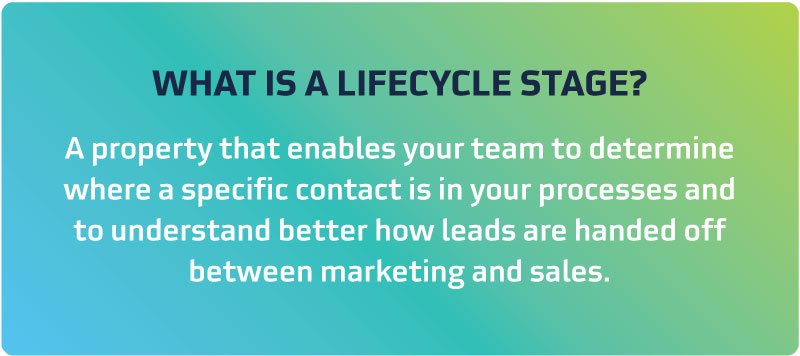HubSpot users are empowered when they know why lifecycle stages matter and how to use them.
Whether you're new to HubSpot or have been using it for a while, as you've looked at your contacts or have tried cleaning them up, the topic of lifecycle stages has probably been mentioned — and if not, it should.
What the heck are lifecycle stages, and why are they important? If you tried changing the stage names, you may have quickly realized that you can't — but why?
Let's take a few minutes to dive into some of these questions. Hopefully, this article will clarify what they are, why they're important, and how to use them.
Lifecycle stages defined
HubSpot defines lifecycle stages as "a property that enables your team to determine where a specific contact is in your processes and to understand better how leads are handed off between marketing and sales."

Let's unpack that for a minute.
HubSpot has eight lifecycle stages by default. The idea is that when someone first completes a form on your website, they start on the lifecycle process and progress through the stages until hopefully becoming a customer or evangelist. While we suggest customizing each lifecycle stage definition to fit your company, HubSpot offers a good starting point.
- Subscriber: A contact who has opted in to hear more from your company by signing up for your blog or newsletter. This is automatically set by HubSpot when a contact converts on a blog subscription form, is created through a conversation, or is manually added to the Contacts index page.
- Lead: A contact who has converted on your website or through some other interaction with your organization beyond a subscription signup. This is automatically set by HubSpot when a contact converts on a lead form, is synced to HubSpot from Salesforce, or is created from a contact profile in Gmail or Outlook.
- Marketing Qualified Lead: A contact that your marketing team has qualified as ready for the sales team.
- Sales Qualified Lead: A contact that your sales team has qualified as a potential customer.
- Opportunity: A contact who is associated with a deal (e.g., they're involved in a potential deal with your organization). If you've selected to sync lifecycle stages in your settings, this is automatically set by HubSpot when a contact or company is associated with an open Deal.
- Customer: A contact with at least one closed deal. If you've selected to sync lifecycle stages in your settings, this is automatically set by HubSpot when at least one deal associated with the contact or company is set to Closed Won.
- Evangelist: A customer who has advocated for your organization.
- Other: A contact who does not fit any of the above stages.
These stages are set up primarily for online leads. That said, we have worked with companies that also do outreach and have managed to work those leads into this process as well. As a best practice, don’t move a contact's lifecycle stage backward; it should only progress through the cycle. While there are some workarounds, the system is not set up to do this, so when you force a lifecycle stage, your reporting will be off.

How to use lifecycle stages
By default, HubSpot uses lifecycle stages to determine your lead and customer reporting. While you can technically rename stages with your own terminology, HubSpot's default reporting will not reflect that. To see a report with your preferred stage names, you'd have to fight functionality to create one that's customized. So, for the quickest and most accurate reporting, stick to HubSpot's stage names.
An important component of the lifecycle stage is how it works with the lead status. In the SQL and Opportunity stages of the lifecycle primarily, sub-steps allow sales reps to notate where a lead is in their process.
The combination of lifecycle stages and sub-steps is important when pulling leads marked as an Opportunity but were unqualified or closed. There's a lot to discuss here, so we'll go into more detail on this in another blog later.
Benefits of a lifecycle stage map
When first setting up or optimizing your data and contacts in HubSpot, we recommend creating a lifecycle stage map. The map can be as simple as this spreadsheet template.
Start by defining each lifecycle stage. For instance, perhaps for your company, a Subscriber is someone who has only subscribed to your blog but has not taken any other action.
From there, document how contacts enter each stage (e.g., filled out a form, got uploaded from a trade show list, etc.). There can be more than one way for contacts to get added to a lifecycle, so list out all the ways you can think of to cover your bases.
Next, record how contacts move to the next stage (i.e., the exit point). If they're a Subscriber, do they need to download an offer or get a specific lead score? Add that information to the spreadsheet. Identifying and documenting these details will help you understand the cycle stages and where contacts fit.
Now, list any actions that need to be taken during each stage. For example, if your marketing team needs to vet contacts before marking them as SQL or if a phone call should be made to contacts before moving them to Opportunity, these actions should be noted. Also, notate if moving to the next stage is automated or if a manual stage change is needed.
Lastly, include who is responsible for each stage. This provides clarity and accountability. It also means that HubSpot can be adjusted so that teams can see the views that are most important to them. For instance, if the sales team is responsible for SQLs and Opportunities, they should see all associated information.
It's important to note that lifecycle stages are also on the Company level. We often recommend that these sync with the contacts unless you can sell different products to multiple people in the company. This means your Contacts and Companies will match unless you have customers and prospects all within one company.
Completing this exercise will help clarify lifecycle stages for your company and provide a path forward for using these fields consistently. When this information is used correctly in HubSpot, you can trust that you'll get accurate and helpful reporting.
Need more HubSpot help?
HubSpot is a powerful tool and, when used correctly, can make all the difference in any business’s marketing, sales, customer service, and RevOps.
To get the most out of HubSpot, it might be time to consider hiring a HubSpot Partner Agency for consulting. It never hurts to meet regularly with HubSpot Sales Hub experts to make sure you’re on target and getting the most out of your investment. Or, it might be time to find a marketing and sales partner to come alongside you for strategy development, execution, and HubSpot assistance. TANK New Media can help with both. Schedule a free, no-obligation 15-minute phone call with us to find out how TANK New Media can help you reach your HubSpot — and sales – goals.
More reading:
Subscribe to Our Blog
Stay up to date with the latest marketing, sales, and service tips.





